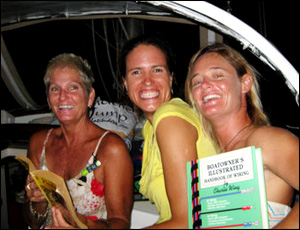In the Women and Cruising blog series “Take Your Passion Cruising” I wrote about my passion: birds.
When you’re cruising, you’re immersed in nature, and many of us enjoy watching the birds while underway or at anchor. But as a boater you’re also in a unique position to contribute to citizen science simply by taking photos of the birds you see on passage and in remote anchorages.
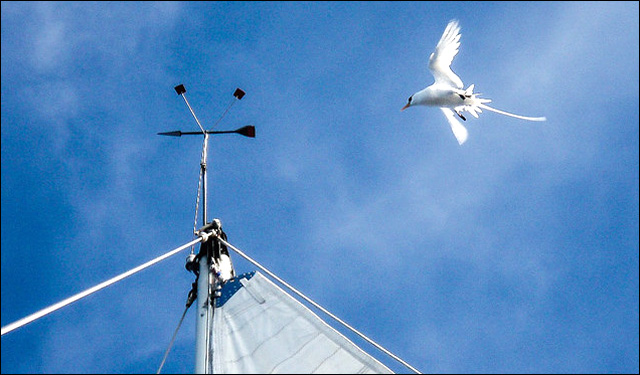
Tropicbirds are commonly reported to the Birding Aboard project, perhaps because they are so elegant and have a habit of circling the mast.
Photo ©Ellen Massey Leonard.
Because there is so little coverage of these areas, the odds are high for a “birder aboard” to contribute notable sightings that help scientists and conservations map bird distribution and abundance.
Here are a few examples of how cruisers can be “the eyes on the water” for birds:
* Sailing vessel s/v Aventura, with the Blue Planet Odyssey through the Northwest Passage, photographed a rare white morph Gyrfalcon cliff-nesting on an island in the Canadian Arctic Archipelago. Their sighting adds to a lone 1999 historical report of a Gyrfalcon at the same location.
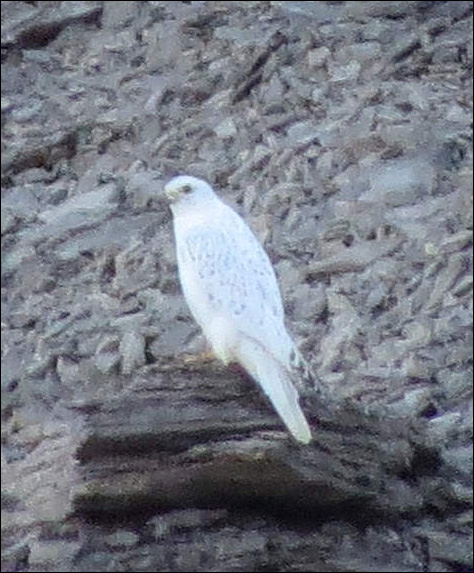
A rare white Gyrfalcon spotted among the cliffs and icebergs
of the Northwest Passage. Photo ©Doina Cornell.
* A 24-year-old who crossed the Atlantic with his father as part of the Atlantic Odyssey fleet, captured stunning photographs of a Trindade Petrel about 1,000 miles east of Martinique. A Trindade Petrel also was reported independently by Dorothy Wadlow on s/v Joyant about 900 miles east of Antigua. Trindade Petrel is a recently split species, considered vulnerable with uncertain global population and range.
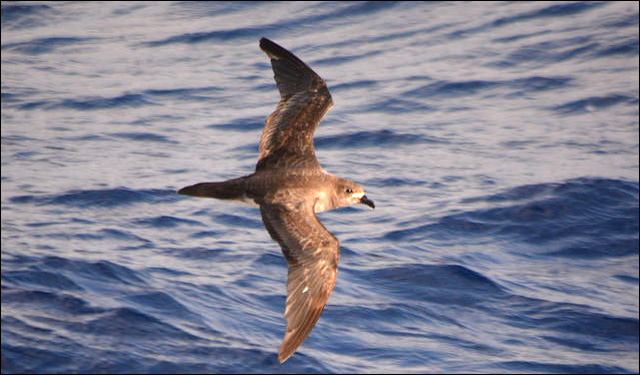
A striking capture of a fast-flying ocean bird, a Trindade Petrel at home a thousand miles from shore. Photo ©Michael Sammer.
* Two homeschooled children, ages 10 and 11, logged all the birds they saw during their two-week transatlantic, scoring a Red-billed Tropicbird and Masked Booby closer to Cape Verdes than their expected stronghold in the Caribbean.
* In that same fleet, s/v Gemm and s/v Fleur de Sel documented flocks of Cattle Egrets in the middle of the Atlantic Ocean, over a thousand miles from Africa or South America. The Cattle Egret has had one of the most wide-reaching and rapid expansions from its native range in Africa, spreading northward through South and North America since first sighted in Guiana in 1877. They are presumed to have flown across the Atlantic Ocean, given that immature Cattle Egrets will disperse up to 3,100 miles from their breeding area. So Lanzarote to Martinique (the Atlantic Odyssey’s passage) is just a jump across the pond!
* Circumnavigator Ellen Massey Leonard collected photos from her and her husband’s round-the-world passage on 38-foot s/v Heretic, contributing noon positions for notable sightings such as Cape Petrel further north than expected in the Indian Ocean, a Brown Noddy hitchhiker off the South African coast, and a Pomarine Jaeger near St. Paul Rocks in the central equatorial Atlantic Ocean.
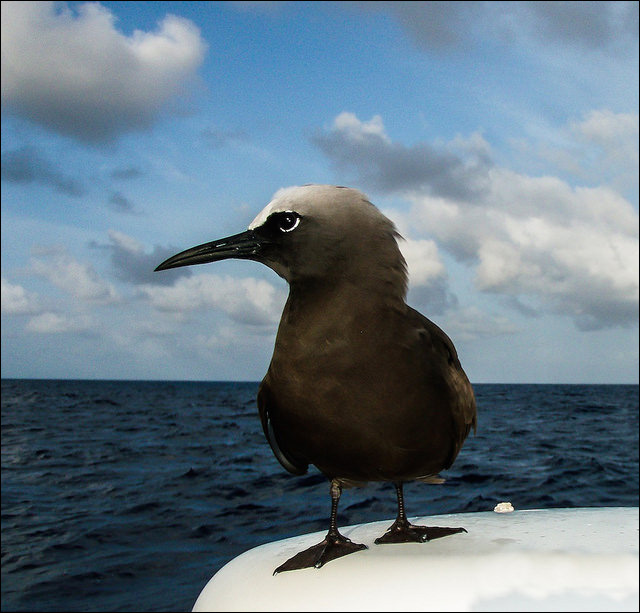
A Brown Noddy claims a radome as its perch halfway between Ascension Island and Barbados. Photo ©Ellen Massey Leonard
* Birding Aboard Advisor and U.K. marine conservationist Colin Speedie on s/v Pelerin sailed through the balmy Lesser Antilles, only to spot several notable birds common to him from his northern home port! These included Great Skua, Pomarine and Parasitic Jaeger, and Cory’s Shearwater.
There were also many reports of hitchhiking land birds, such as Bobolink, Golden-crowned Kinglet, Barn Swallow, Mangrove Swallow, Caribbean Martin, Northern Flicker, and Blackpoll Warbler. These sightings reinforce recent tracking evidence that tiny songbirds are able to migrate long distances over the ocean and are not all “storm waifs.”
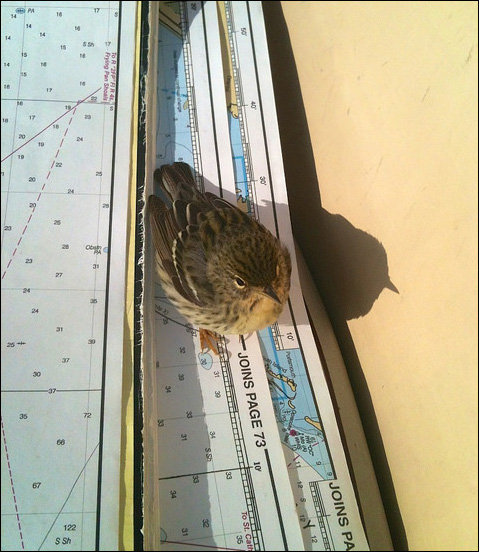
A tiny Blackpoll Warbler, a migrant between Canada and South America, rests in the cockpit of s/v Cinderella about 20 miles off the Florida coast.
Photo ©Jaye Lunsford.
Going forward, the project is anticipating exciting reports from Blue Planet Odyssey vessels sailing to Tokelau and Vanuatu, another season of attempts through the Arctic’s Northwest Passage, a sailboat cruising the Scandinavian Arctic, and OceansWatch Donna Lange’s solo circumnavigation. And we hope for even more sightings from coastal and offshore cruisers like you!
The “SeaBC” Sea Bird Count is:
- A Clean Wake Project of the Seven Seas Cruising Association
- An Environmental Programme of the Ocean Cruising Club
- A Project of the Blue Planet Odyssey
For more information on how to participate, visit www.birdingaboard.org or the Birding Aboard Facebook group.
About Diana Doyle
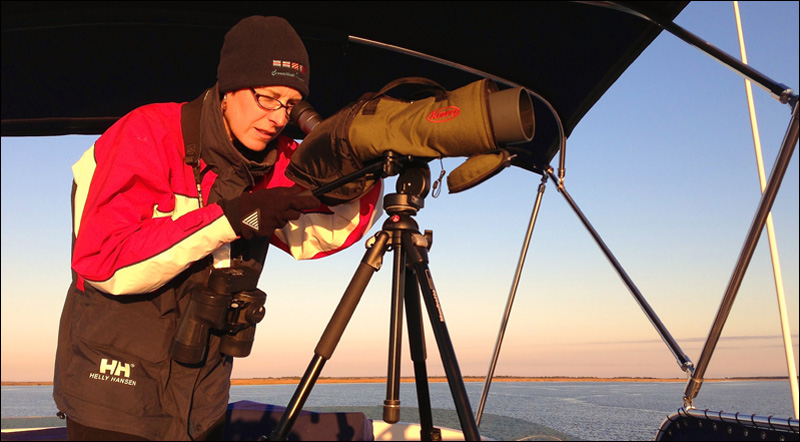 Diana Doyle and her husband Mark write the Intracoastal Waterway cruising guide series, On the Water ChartGuides. They work- and live-aboard their PDQ catamaran Semi-Local.
Diana Doyle and her husband Mark write the Intracoastal Waterway cruising guide series, On the Water ChartGuides. They work- and live-aboard their PDQ catamaran Semi-Local.
Diana holds a 50-ton USCG Master’s License, but she especially loves launching her onboard kayak since it gets her closest to the wildlife.
She also writes for birding magazines and is currently the Tools of the Trade Editor for American Birding Association’s Birding magazine.
More from this website
- Diana Doyle enjoys “birding aboard” as she writes cruising guides
- Women cruisers organize seabird citizen science project, by Diana Doyle
- Chance encounters between ships and whales, by Daria Blackwell

